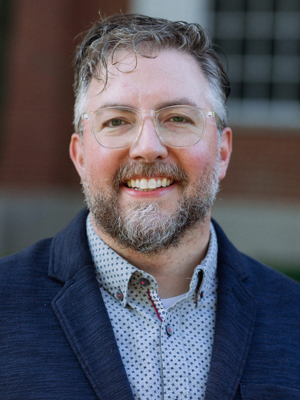February 3, 2025
Wheaton College Visiting Associate Professor of Art History Dr. Taylor Worley will use his 18-month grant to complete his project titled “Art and Transformation: Convening Integrative Perspectives on Aesthetics, Creativity, and Spirituality.”
 Building on previous projects, Dr. Worley’s current work focuses on how the arts can transform how individuals perceive themselves, the world, and the divine. Worley seeks to integrate empirical methods of psychological science with insights of theological aesthetics. By fostering interdisciplinary dialogue and collaboration, he aims to enrich both fields, leading to a deeper understanding of the nature of beauty, art, and human perception.
Building on previous projects, Dr. Worley’s current work focuses on how the arts can transform how individuals perceive themselves, the world, and the divine. Worley seeks to integrate empirical methods of psychological science with insights of theological aesthetics. By fostering interdisciplinary dialogue and collaboration, he aims to enrich both fields, leading to a deeper understanding of the nature of beauty, art, and human perception.
Worley plans to use this Templeton grant to continue collaborating with researchers he has worked with both at Wheaton and throughout the world, ultimately producing an edited volume on art and transformation. Significant funds will go toward identifying and sourcing a range of individuals from various academic disciplines who can contribute to the work.
“I want to try and find out what different people—including art historians, theologians, psychologists, neuroscientists, and social scientists—mean when they use the term ‘transformation’ when it comes to artworks,” said Worley.
The grant will enable Worley to lay the groundwork for two larger goals. The first is creating platforms for short-term theologian fellowships at empirical aesthetics labs like the Vienna Cognitive Science Hub at the University of Vienna or the Penn Center for Neuroaesthetics at the University of Pennsylvania. The second is finding “artist theologians,” as Worley describes them, who would be interested in collaborating with these empirical aesthetics labs.
Worley’s motivation for his work stems from his conviction, developed in recent years, that the arts play a significant role in helping to heal the divided socio-cultural landscape he has observed in the U.S.
“Rather than seeing the arts as an optimal leisurely activity, I think they do a lot more for us than that,” said Worley.
Worley has observed that the art individuals encounter in museums and galleries can be confusing and difficult to understand, especially works in the style of contemporary art. These encounters differ, for example, from what one experiences on their social media feed, which algorithms curate based on personal preferences. Worley believes that when those in a society only consume what they already like and understand, it is not helpful for anyone.
“That’s an emotionally, mentally, and ethically unhealthy diet,” said Worley. “The internal work that can happen in front of a work of art that often begins in the place of confusion, uncertainty, and feeling confounded can actually be really healthy for us when we’re in our neighborhoods or our homes, and we’re dialoguing with people with different opinions and perspectives. I’m convinced that we need these spaces of uncertainty where we can exercise some humility and patience with things we don't understand.”
—Juliana Bacote